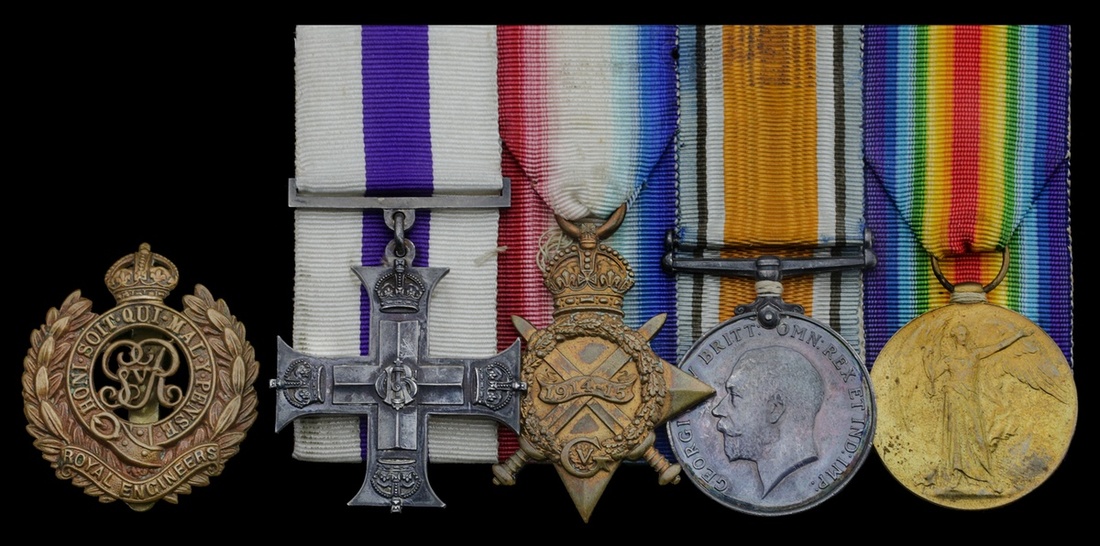
Auction: 20001 - Orders, Decorations and Medals - conducted behind closed doors
Lot: 671
(x) A Great War 'Birthday Honours' M.C. group of four awarded to Captain H. A. E. Browne, Royal Engineers, scion of a large Irish family, who narrowly avoided the loss of the RMS Lusitania and forged a long and successful career as an architect and engineer in Vancouver
Military Cross, G.V.R. (Capt. H. A. E. Browne, R.E.); 1914-15 Star (2. Lieut. H. A. E. Browne. R.E.); British War and Victory Medals (Capt. H. A. E. Browne), the first privately engraved to reverse, minor contact marks, very fine (4)
M.C. London Gazette 4 June 1917.
Hugh Alexander Edgar Browne was born on 21 June 1885 at Belfast (Down), County Down, Northern Ireland, the sixth child of John Monteagle Brown of Tullycarnet, Ardgless, formerly of Knock, Belfast. His family had followed two distinct pathways over the previous 50 years, those of engineering and the military, one relation being Captain Peter Brown, builder of the George Halpin-designed lighthouse at St. John's Point, County Down.
As a young man Browne was a prominent member of the Knock Rugby Football Club and captained the second XV when they won the Junior Cup. He also played for Ulster in the Junior-Inter provincial. Upon leaving school, Browne qualified as an architect and civil engineer and was employed as a member of the family firm Browne Brothers, architects and civil engineers of Tullycarnan. The firm acted as architects for the new local Masonic Hall which was opened on 20 April 1912, and also for the Scottish Temperance Buildings in Belfast.
Emigrating to Canada after a brief spell working in Kensington, London, Browne decided to return to England in 1915 and join the British Army and 'to follow the example of his brothers'. The eldest, Captain John Plunkett Browne was serving with the Royal Inniskilling Fusiliers whilst another, Lieutenant-Colonel Edgar Monteagle Browne commanded a battalion of the Royal Munster Fusiliers. A third and the youngest Browne, Captain Martin G. Browne further served with the Royal Artillery. As a result, he purchased a ticket at New York and travelled across the North Atlantic aboard the Cunard liner RMS Lusitania, arriving at Liverpool on 11 April 1915. Less than a month later on 7 May 1915 during the return voyage to North America, the Lusitania was identified and torpedoed by the U-20, sinking in 18 minutes 11 miles off the Old Head of Kinsale. 1198 persons aboard drowned, the sinking turning public opinion in many countries against Germany and heavily contributing to the American entry into the Great War, the mood heightened by iconic posters of innocent women and children going down with the ship. For Browne it had been a close call; the Lusitania had fallen victim to a torpedo attack relatively early in the war before tactics for evading submarines were properly implemented or understood.
Appointed to a commission in the Royal Engineers, Browne served in France from 5 November 1915, initially as a 2nd Lieutenant with the 9th Field Company. Serving as part of 4th Division, the 9th witnessed extensive service at Albert from 1-13 July 1916 and Le Transloy from 1-18 October 1918. They witnessed considerable action at Polygon Wood from 26 September - 3 October 1917 and were heavily engaged in operations around Drocourt-Queant and the Canal Du Nord. Promoted Captain, Browne may have witnessed the visit of King George V to the 4th Division at Valenciennes on 4 December 1918.
Having survived three years of trench warfare, Browne returned to England where he married Eleanor Frances Booth at St. Thomas, Heaton-Norris, Lancashire, on 14 August 1919. The couple returned to Canada and set up home in Montreal followed by Medicine Hat and Vancouver. The 1930 Vancouver Directory later shows them living at 2930 West 38th Street, Browne being employed by the City of Vancouver as a civil engineer. In 1936 he is described as a draughtsman at City Hall and in 1948 he moved to 3021 West 29th Street, Vancouver, being promoted to Assistant Engineer for the City. He died on 14 August 1962 in Vancouver, being buried in Mountain View Cemetery; sold with copied research and MIC details together with a contemporary Royal Engineers brass cap badge.
Subject to 5% tax on Hammer Price in addition to 20% VAT on Buyer’s Premium. For more information please view Terms and Conditions for Buyers.
Sold for
£950
Starting price
£420




